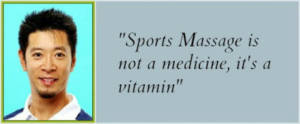
In part 2 of our interview, Roy Chan explains the difference between regular massage & sports massage and how it can help athletes to perform better.
Roy Chan, qualified Sports Massage Therapist with special focus on rehabilitation massage and injury prevention. He is therapist to Hong Kong’s elite sports teams working in particular with triathletes and rowers:
1) What are the main benefits and effects of Sports Massage? And how is it different to other massage types?
Sports Massage, as opposed to regular massage types like Swedish Massage for example, has a precise focus and includes in-depth movement analysis. It’s closely related to sports physiotherapy. Therapists work on a specific problem creating a tailor-made pre- and post-race treatment plan for the athlete. Let’s say the client suffers from a tight hamstring. In a short therapy session of max. 30 minutes, the Sports Massage therapist only focuses on releasing the muscle tension. By analyzing his activities or specific movements, the therapist can also recommend strengthening and conditioning exercises to complement his regular training.
Sports Massage is a very detailed procedure with the goal to enhance an athlete’s overall performance. There are three stages:
1) Pre-Event: Before a race or competition, a fast-paced massage stimulates the muscles and helps the body to warm up
2) Inter-Event: In sports such as tennis or rugby where athletes have short breaks or time-outs, therapists can release muscle tensions with a quick massage
3) Post-Event: Approx. 3-4 hours after a race or competition when the athlete’s body has properly cooled down, therapists use massage for muscle recovery and rehabilitation
Sports Massage is not only for top athletes. I recommend it to any amateur athlete who trains and competes regularly.
2) How do aromatherapy and sports massage complement each other?
Aromatherapy and sports massage is a great combination for warm up or post-race recovery. Essential Oils such as Black Pepper, Ginger, and Lemongrass for example can help heating up the muscles.
But a word of caution for top athletes: Some Essential Oils such as Geranium are on the List of Prohibited Substances and Methods by the World Anti-Doping Agency. Athletes need to check regularly for updates.
3) Can you share some tips for athletes participating in the upcoming HK Marathon?
For pre-race preparation, athletes should include 2 hours of sports massage per week in their training routine. For post-race recovery, athletes should wait for a few hours after the race before having any massage. The body needs time to cool down first – a cold bath helps the circulation to slow down (in most cases, hot water is not comfortable for athletes as muscles are swollen).
In general, training for races and competitions should be regular and long-term. Nutrition and sports massage are important factors which contribute to a successful performance. I recommend reserving one quarter of an athlete’s training for maintenance. Amateur athletes shouldn’t hesitate to seek assistance from a qualified sports massage therapist who can create a personalized whole body treatment program. When choosing a therapist, clients shouldn’t be shy to ask about his background and qualifications. A vast knowledge about anatomy and movement analysis is essential. Massage is not a medicine, but a vitamin!
Thank you, Roy! If you are interested to learn more about the benefits of sports massage or would like to work with Roy, please email or call us: +852 2882 2444.
To read the first part of our interview with triathlete Shiila click here.
